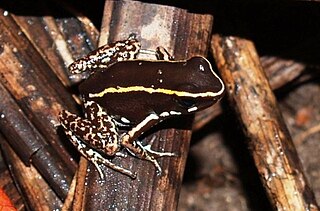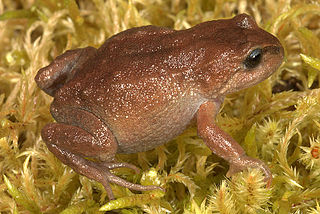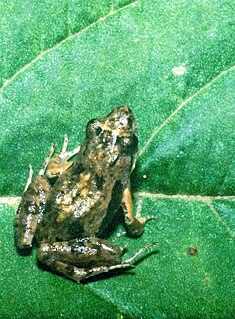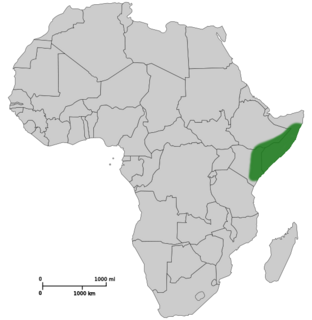
Limnodynastes dumerilii is a frog species from the family Limnodynastidae. The informal names for the species and its subspecies include eastern or southern banjo frog, and bull frog. The frog is also called the pobblebonk after its distinctive "bonk" call, which is likened to a banjo string being plucked. There are five subspecies of L. dumerilii, each with different skin coloration. The species is native to eastern Australia. There has been one occurrence in New Zealand, when tadpoles of the species were found in 1999 and destroyed.
Arthroleptis lameerei is a species of frog in the family Arthroleptidae. It is found in northeastern Angola, southeastern Democratic Republic of the Congo, and western Burundi, though the exact range is poorly known. There is some doubt whether it is distinct from Arthroleptis xenochirus. The specific name lameerei honours Auguste Lameere, a Belgian entomologist. Common names Lameere's squeaker, Lameer's squeaker, and Katanga screeching frog have been coined for this species.

The lovely poison frog or lovely poison-arrow frog is a species of frog in the family Dendrobatidae. It is found on the Caribbean versant of Central America from southeastern Nicaragua through Costa Rica to northwestern Panama, with one record just west of the Panama Canal. Populations from the Pacific versant, formerly included in this species, are now identified as Phyllobates vittatus.
Sarcohyla cyanomma, also known as the blue-eyed aquatic treefrog, is a species of frog in the family Hylidae. It is endemic to Mexico and only known from the northern slope of Cerro Pelón, in Sierra de Juárez in northern Oaxaca. It is feared that the species might be extinct.

Hyperolius spinigularis is a species of frog in the family Hyperoliidae. It is found in the Mulanje Massif in southern Malawi and the Namuli Massif in adjacent Mozambique. Records from Tanzania refers to other species. Males of this species have characteristic small spines during the breeding season. Its common names are spiny-throated reed frog, spiny reed frog, and Mulanje reed frog.

Leptopelis parkeri is a species of frog in the family Arthroleptidae. It is endemic to Tanzania and known from the Eastern Arc Mountains. Specifically, it has been recorded from Uluguru, Udzungwa, East and West Usambara, Nguru, and South Pare Mountains. Common names Parker's tree frog and Parker's forest treefrog have been coined for it. It is named after Hampton Wildman Parker, a British zoologist and herpetologist from the Natural History Museum, London.
Phlyctimantis boulengeri is a species of frog in the family Hyperoliidae. Its distribution area consists of three disjunct areas: western one in Ivory Coast, southeastern Guinea, Liberia, and southern Ghana, and another one in southeastern Nigeria, western Cameroon, and Gabon, and finally, the Bioko island. The record from Gabon may refer to Phlyctimantis leonardi, and the western populations might belong to an undescribed species. It occurs in secondary forests, forest clearings, and farm bush. Breeding takes place in larger temporary ponds in forest.

Phlyctimantis leonardi is a species of frog in the family Hyperoliidae. It is found in west-central Africa in eastern Cameroon, Equatorial Guinea, Gabon, Republic of the Congo, and western Democratic Republic of the Congo. It is presumed to occur in the Cabinda enclave of Angola. It might be the same species as Phlyctimantis verrucosus found further east, showing clinal variation. Frogs are medium to large, with smooth skin.
Pristimantis repens, known commonly as the Galeras robber frog, is a species of frog in the family Craugastoridae. It is endemic to the Colombian Massif in the Nariño Department, Colombia. The specific name repens is Latin for creeping or crawling, inferred to be its mode of locomotion based on its short limbs.

Leptodactylus mystacinus is a species of frog in the family Leptodactylidae. It is found in eastern Bolivia and eastwards to Brazil, Paraguay, and Uruguay and southwards to central Argentina. It is also known as the mustached frog.

Bryophryne cophites, also known as the Cusco Andes frog or the Cuzco Andes frog, is a species of frog in the family Craugastoridae. It is endemic to Peru and known only from slopes of the Abra Acanacu in the Cordillera de Paucartambo, Cusco Region. There is an unconfirmed record from a neighboring mountain range, so this species might be more widespread than current knowledge suggests.

Scaphiophryne marmorata is a species of frog in the family Microhylidae. It is commonly known as the green burrowing frog and the marbled rain frog. It is endemic to Madagascar. It is classified as "Vulnerable" by the IUCN as it is threatened by habitat loss.

Phrynobatrachus parvulus is a species of frog in the family Phrynobatrachidae. It is widely distributed in the upland areas of Central and East Africa in Angola, northern Botswana, northern Zimbabwe, Zambia, southeastern Democratic Republic of the Congo, Malawi, and Tanzania. However, many identifications are problematic, and the taxonomic status of this species with respect to Phrynobatrachus mababiensis and P. ukingensis requires clarification; in the more inclusive species delimitation applied by the IUCN SSC Amphibian Specialist Group, also Uganda is tentatively included in the range of this species. Common names Loanda river frog, dwarf puddle frog, and little puddle frog have been proposed for this species.
Phrynobatrachus steindachneri is a species of frog in the family Phrynobatrachidae. It is found in western Cameroon and eastern Nigeria. The specific name steindachneri honours Franz Steindachner, an Austrian herpetologist and ichthyologist. This species is also known as Steindachner's puddle frog and Steindachner's river frog.
Phrynobatrachus ukingensis is a species of frog in the family Phrynobatrachidae. It is recorded in several places in southern and eastern Tanzania and in northern and southern Malawi ; it probably occurs more widely, at least in areas in between the known localities. Common names Ukinga puddle frog and Ukinga river frog have been coined for it.

Hildebrandtia macrotympanum is a species of frog in the family Ptychadenidae. It is a rarely seen fossorial frog that is found in southern Ethiopia, Kenya, and Somalia. Common names Somali ornate frog, northern ornate frog, and plain burrowing frog have been proposed for it.
Ptychadena guibei is a species of frog in the family Ptychadenidae. It is found in northeastern and eastern Angola, the Caprivi Strip of northeastern Namibia, northern Botswana, northwestern and eastern Zimbabwe, Zambia, southern Democratic Republic of the Congo, Malawi, and northern Mozambique. The specific name guibei honours Jean Guibé, a French zoologist and herpetologist. Common names Guibe's yellow-bellied grass frog, Guibe's grass frog, Guibe's grassland frog, and Guibe's ridge frog have been coined for it.

Delalande's sand frog, also known as Delalande's frog, Cape sand frog, or striped pixie, is a species of frog in the family Pyxicephalidae. It is endemic to western and southern South Africa and occurs in the low-lying areas of Namaqualand, Western Cape, and Eastern Cape as far east as Cape St. Francis.

Hylarana taipehensis is a species of "true frog", family Ranidae. It has several common names, including Taipei frog, Taipei grass frog, two-striped grass frog, or striped slender frog. Following its redelimitation in 2019, its range is now believed to extend from Taiwan and southern China to Vietnam, Laos, Cambodia, and eastern Thailand.
Platymantis bayani is a species of frog in the family Ceratobatrachidae. It is endemic to the island of Samar, the Philippines. It is only known from its type locality, the Taft Forest Reserve in Taft, Eastern Samar. The specific name bayani is derived from the Tagalog word meaning "highly respected", "heroic", or "hero". The name honors Walter C. Brown, in recognition of his "numerous contributions to Philippine herpetology and … lifelong commitment to the study of biodiversity in the SW Pacific." Accordingly, common name Walter's limestone forest frog has been proposed for this species.












